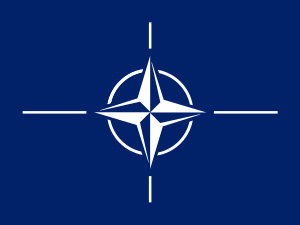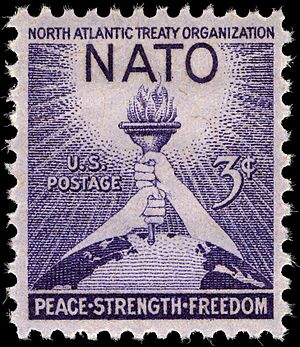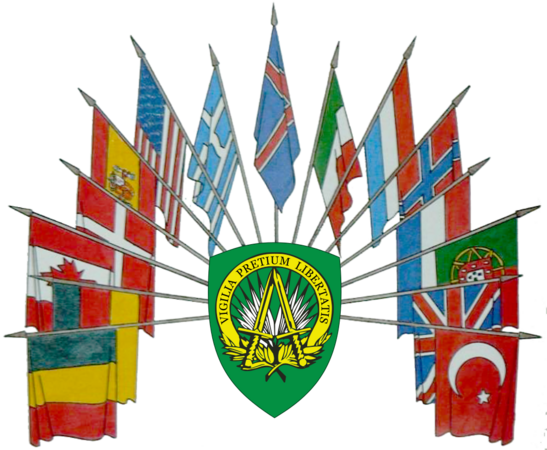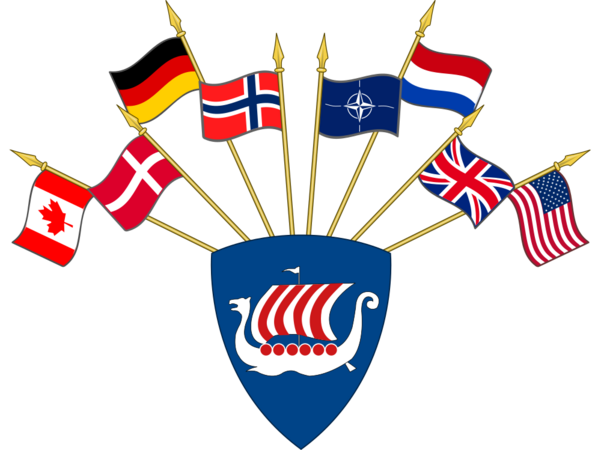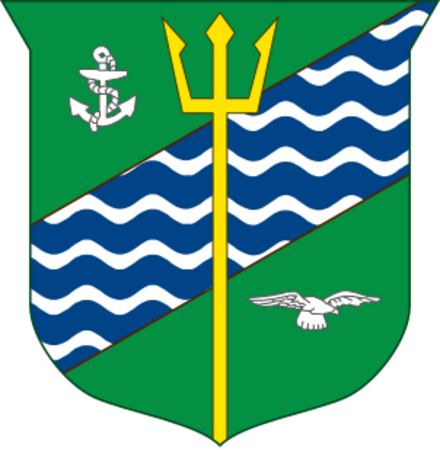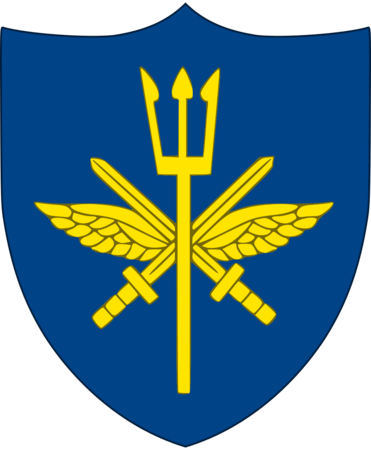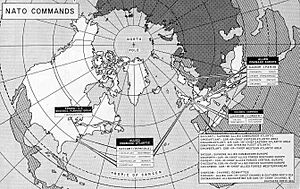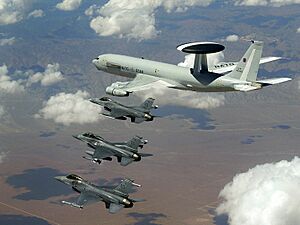History of NATO facts for kids
The North Atlantic Treaty Organization (NATO) is a military alliance that started after World War II. It was created to help countries protect each other, especially from the Soviet Union. The United Kingdom and France first signed a defense agreement in 1947. This agreement grew in 1948 to include Belgium, the Netherlands, and Luxembourg.
In 1949, the alliance became NATO. It added the United States, Canada, Italy, Portugal, Norway, Denmark, and Iceland. Over the years, more countries joined. These include Greece and Turkey (1952), West Germany (1955), Spain (1982), Czech Republic, Hungary, and Poland (1999). In 2004, Bulgaria, Estonia, Latvia, Lithuania, Romania, Slovakia, and Slovenia joined. Later, Albania and Croatia (2009), Montenegro (2017), North Macedonia (2020), Finland (2023), and Sweden (2024) also became members.
NATO's military structure changed over time, especially during and after the Cold War. In 1950, an organized military structure was set up. This was to improve defenses against a possible Soviet attack. By 1951, Allied Command Europe (ACE) and its main headquarters, called SHAPE, were created.
Contents
How NATO Began
NATO's beginnings can be traced back to the Atlantic Charter in 1941. This was an agreement between the United States and the United Kingdom. It aimed for countries to work together after World War II without trying to take over new lands.
The Treaty of Brussels was a defense agreement signed in 1948. It brought together Belgium, the Netherlands, Luxembourg, France, and the United Kingdom. This treaty was a first step towards NATO. The Soviet Union's actions, like the Berlin Blockade in 1948, made Western countries worried. They felt a strong need for a combined defense. However, the countries involved were not strong enough alone. British Foreign Minister Ernest Bevin pushed for a joint Western military plan. The United States also supported this idea, especially because of concerns about the Italian Communist Party.
NATO During the Cold War (1949–1991)
The Cold War was a long period of tension between the Western countries (led by the US) and the Eastern Bloc (led by the Soviet Union). NATO played a big role in this period.
Early Years and Growth (1949–1962)
In 1948, European and US officials met to plan a new alliance. This led to the North Atlantic Treaty, signed on April 4, 1949. The first NATO Secretary General, Lord Ismay, famously said NATO's goal was "to keep the Russians out, the Americans in, and the Germans down." Some people in Iceland protested joining NATO, wanting their country to remain neutral.
- Collective Defense: NATO members agreed that an attack on one member in Europe or North America was an attack on all. If this happened, each member would help the attacked country. This could include using armed force to keep the area safe. The treaty allows members to choose how they respond, but military help is expected.
- Standardization: NATO helped its members use similar military terms, procedures, and technology. This meant many European countries started using US practices. For example, the 7.62×51mm NATO rifle cartridge became a standard for many rifles. Even aircraft landing signals were made the same. The NATO phonetic alphabet (like Alpha, Bravo, Charlie) also became widely used.
The Korean War in 1950 made NATO realize it needed stronger military plans. In 1951, Supreme Headquarters Allied Powers Europe (SHAPE) was set up to lead forces in Europe. Dwight Eisenhower became its first commander. NATO aimed to have many divisions (large military units) ready to defend against a Soviet invasion. The role of Secretary General of NATO was also created to lead the civilian side of the organization.
In 1952, NATO held its first big naval exercises, called Exercise Mainbrace. Over 200 ships and 50,000 people practiced defending Denmark and Norway. Other large exercises followed, testing different military skills.
Greece and Turkey joined NATO in 1952. This led to talks about how to include them in the military structure. Secret plans, like Operation Gladio, were also made. These plans were to continue resistance if the Soviets invaded.

In 1954, the Soviet Union surprisingly suggested joining NATO. NATO countries rejected this idea, fearing it was a trick to weaken the alliance. NATO also decided that it would use atomic weapons early in a war with the Soviet Union if needed.
The joining of West Germany in 1955 was a major event. NATO saw Germany's soldiers as vital to resist a Soviet attack. In response, the Soviet Union and its allies formed the Warsaw Pact in 1955. This clearly divided Europe into two opposing sides during the Cold War.
France's Strained Relations with NATO
NATO's unity faced a challenge when French President Charles de Gaulle (1959–1969) was in power. De Gaulle felt the United States had too much control in NATO. He wanted France to have an equal say.
De Gaulle began building France's own independent defense force. He wanted France to be able to make a separate peace with the Eastern Bloc if there was a conflict. In 1959, France pulled its navy from NATO command. It also banned foreign nuclear weapons from French soil. This led the US to move 300 military aircraft out of France.
Even though France supported NATO during the Cuban Missile Crisis in 1962, de Gaulle continued to seek independence. In 1966, all French armed forces were removed from NATO's integrated military command. All non-French NATO troops were asked to leave France. This forced SHAPE, NATO's main headquarters, to move from near Paris to Casteau, Belgium, in 1967. France remained a member of the alliance, committed to defending Europe, but with its own forces. Secret agreements were made for French forces to rejoin NATO's command if a major conflict broke out. France fully rejoined NATO's military command in 2009.
Détente and Escalation (1962–1991)

For most of the Cold War, NATO did not engage in direct military action. In 1968, the Treaty on the Non-Proliferation of Nuclear Weapons was signed. NATO said its nuclear sharing plans did not break this treaty. In 1978, NATO set two goals: keeping security and working towards "détente" (a period of reduced tension). This meant having enough defenses without causing an arms race.
In 1979, NATO decided to deploy US cruise missiles and Pershing II nuclear weapons in Europe. This was in response to the Warsaw Pact's growing nuclear power. This policy, called the Dual Track policy, aimed to strengthen the West's position in nuclear disarmament talks. In the 1980s, NATO deployed more modern missiles. This led to many peace movement protests in Western Europe.
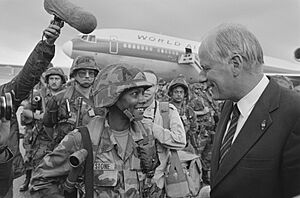
NATO's membership stayed mostly the same during this time. In 1974, Greece temporarily left NATO's military command due to the Turkish invasion of Cyprus. It rejoined in 1980. The Falklands War between the UK and Argentina did not involve NATO. This was because NATO's collective defense only applies to attacks on member territories north of the Tropic of Cancer.
On May 30, 1982, Spain became a new NATO member. This was confirmed by a vote in 1986. At the height of the Cold War, NATO had about 5.2 million active military personnel.
NATO After the Cold War (1991–Present)
The end of the Cold War and the breakup of the Warsaw Pact in 1991 changed NATO's role. NATO had to rethink its purpose and focus.
Responding to New Challenges (1991–2001)
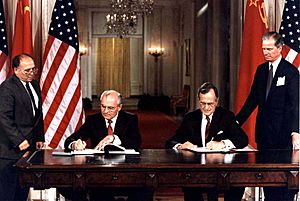
NATO began to expand, including countries from Central and Eastern Europe. It also started getting involved in political and humanitarian issues.
- German Reunification: On October 3, 1990, East Germany joined West Germany. This meant a united Germany became part of NATO. To get Soviet approval, it was agreed that foreign troops and nuclear weapons would not be placed in eastern Germany. There are different views on whether informal promises were made about NATO not expanding further east.
- New Partnerships: Between 1994 and 1997, NATO created new ways for countries to work together. These included the Partnership for Peace and the Mediterranean Dialogue. In 1998, the NATO–Russia Permanent Joint Council was set up to improve relations.
- First Post-Cold War Expansion: On July 8, 1997, three former communist countries were invited to join NATO: Hungary, the Czech Republic, and Poland. All three accepted. Czech President Vaclav Havel said this meant his country was finally part of a strong security alliance. Polish Foreign Minister Bronislaw Geremek said Poland was returning "where she has always belonged: the free world."
- Criticism of Expansion: Some experts in the US criticized this expansion. George F. Kennan, a diplomat, thought it might harm Russian democracy and bring back Cold War tensions. However, NATO continued to expand.
- More Members: In 2004, seven more Central and Eastern European countries joined NATO: Estonia, Latvia, Lithuania, Slovenia, Slovakia, Bulgaria, and Romania.
- France's Return: In 2009, France fully rejoined NATO's military command structure. This was a major change in France's defense policy.
The War on Terror (2001–2008)

The September 11 attacks on the United States in 2001 were a turning point. For the first time, NATO used Article 5 of its treaty. This article states that an attack on one member is an attack on all.
- NATO Response Force: In 2002, the NATO Response Force (NRF) was created. This is a highly ready, multinational force that can deploy quickly.
- Command Changes: In 2003, NATO's military commands were reorganized. Allied Command Transformation (ACT) was set up in the US to focus on future military capabilities. SHAPE became Allied Command Operations (ACO), responsible for current operations.
- Baltic Air Policing: Since 2004, NATO has provided jet fighters to protect the airspace of Latvia, Lithuania, and Estonia. This helps ensure their sovereignty.
- Energy Security: The 2006 Riga summit, held in Latvia (a former Soviet country), focused on the important issue of energy security.
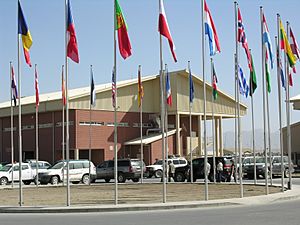
Renewed Focus on Defense (2008–Present)
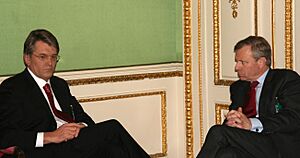
At the 2008 Bucharest summit, NATO invited Albania and Croatia to join. They became members in 2009. Georgia and Ukraine were also told they could join later. This idea, along with NATO's plans for a missile defense system, caused strong criticism from Russia. Russia saw these actions as a threat.
- Cyber and Space Warfare: In 2016, NATO officially recognized cyberwarfare as a domain of war. This means a cyber attack on a NATO member can trigger Article 5. In 2019, space warfare was also recognized as a domain of war.
- New Members: Montenegro joined NATO in 2017, despite objections from Russia. North Macedonia became the 30th member in 2020 after a long-standing name dispute was resolved.
- Crimea and Defense Spending: The 2014 Russian annexation of Crimea was strongly condemned by NATO. At the 2014 Wales summit, NATO members agreed to spend at least 2% of their country's wealth (GDP) on defense by 2024. In 2015, NATO created a new "spearhead" force of 5000 troops. These troops are based in countries like Estonia, Lithuania, Latvia, Poland, Romania, and Bulgaria.
- Tensions with Turkey: Recent years have shown some disagreements between Turkey and other NATO members. This is due to Turkey's actions in Syria, Libya, and its disputes over sea areas.
- Russian Invasion of Ukraine: The 2022 Russian invasion of Ukraine led eight NATO countries to use Article 4. This article allows members to discuss threats to their security. NATO strongly condemned the invasion. Elements of the NATO Response Force were activated for the first time. NATO members also agreed to set up four new battlegroups in Bulgaria, Hungary, Romania, and Slovakia. The aircraft carrier USS Harry S. Truman was placed under NATO command for the first time since the Cold War.
- Finland and Sweden Join: As a direct result of the invasion, both Finland and Sweden applied to join NATO. Finland joined in 2023, and Sweden joined in 2024.
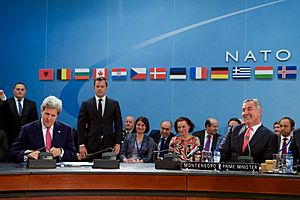
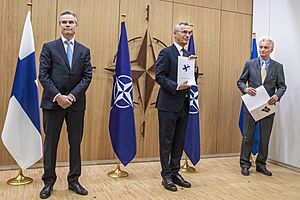
How NATO is Organized
NATO has both civilian and military parts that work together. The Defence Planning Committee used to be a main decision-making body for military matters. Its duties were taken over by the North Atlantic Council in 2010.
Civilian Structure
The civilian side of NATO is led by the Secretary-General. There are different divisions that handle political affairs, economics, finance, production, and logistics. These divisions prepare plans for the Council and its committees. There are also offices for statistics, finance, and information. The Information Division shares facts about NATO with member governments and handles press relations.
Military Structure
The military structure is led by Strategic Commanders. These commanders oversee different levels of command. The Military Committee used to have a Standing Group with representatives from France, the US, and the UK. This group was removed in 1967 when France left the military command structure.
- Coats of arms of historical NATO commands
Early Military Setup
A key step in setting up NATO's military command was choosing General Dwight Eisenhower as the first Supreme Allied Commander Europe (SACEUR) in 1950. He and his team quickly designed a structure for Allied Command Europe. This command was divided into three regions:
- Allied Forces Northern Europe (Scandinavia, North Sea, Baltic)
- Allied Forces Central Europe
- Allied Forces Southern Europe (Italy and the Mediterranean)
SHAPE was set up near Paris, France. When Greece and Turkey joined in 1952, Allied Land Forces South-Eastern Europe (LANDSOUTHEAST) was created in Turkey. This was due to the distance and political disagreements.
In 1952, two more major commands were added:
- Allied Command Atlantic (ACLANT)
- Allied Command Channel (ACCHAN) to control the English Channel and North Sea.
When France left the military command in 1966, NATO's headquarters had to move. SHAPE moved to Casteau, Belgium. Headquarters Allied Forces Central Europe moved to Brunssum, Netherlands.
Structure After the Cold War
After the Cold War, NATO's military structure was reduced and reorganized. By 1991, it was clear that the main defensive forces could be smaller. Six multinational corps (large military units) replaced the previous eight.
In 1994, Allied Command Channel was removed, but many of its parts were kept. From 1994 to 1999, Allied Command Europe had three main commands: AFNORTHWEST, AFCENT, and AFSOUTH. In 1995, NATO began studying how to change its strategy and structure after the Cold War.
In 1996, new recommendations came out for a simpler structure. The number of major commands in Europe was cut from three to two: Regional Command North Europe and Regional Command South Europe. These new commands started in 1999 and 2000. Each oversaw air, naval, and land commands for their region.
Organizations and Agencies
NATO has many different organizations and agencies that help it function. These include:
- Logistics: Agencies that handle supplies and maintenance, like the NATO Maintenance and Supply Agency.
- Production Logistics: Organizations like the NATO Eurofighter and Tornado Management Agency.
- Standardization: The NATO Standardization Agency helps make sure military practices are similar across member countries.
- Civil Emergency Planning: Committees and centers that plan for civilian emergencies.
- Air Traffic Management and Air Defence: Groups like the NATO ACCS Management Agency that manage air control systems.
- Early Warning: The NATO Airborne Early Warning and Control Programme Management Organisation (NAPMO) manages early warning aircraft.
- Consultation, Command and Control: Agencies like the NATO Consultation, Command and Control Agency (NC3A) handle communications and information systems.
- Research and Technology: The NATO Research and Technology Organisation (RTO) conducts research.
- Education and Training: Colleges and schools for training military personnel.
- Project Offices: Offices that manage specific projects, like the Alliance Ground Surveillance Capability.
- Medical Services: The Committee of Chiefs of Military Medical Services in NATO (COMEDS) coordinates medical services.
- Innovation: The Defence Innovation Accelerator for the North Atlantic (DIANA) supports new defense technologies.
|


